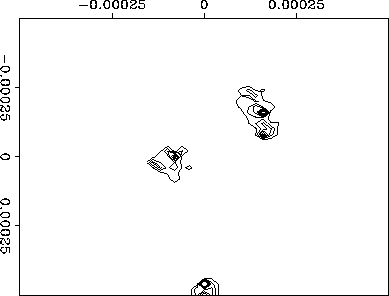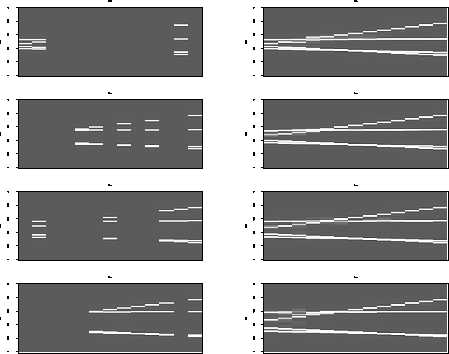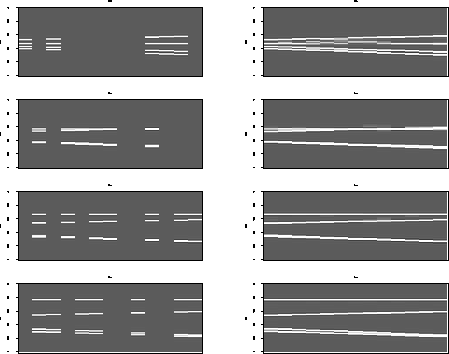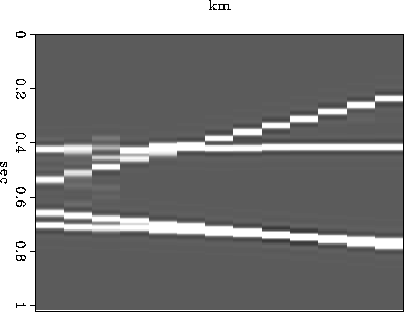




Next: FIELD DATA EXAMPLE
Up: Cole & Claerbout: 3-D
Previous: IMPLEMENTATION
In this section, we test the algorithm on a simple synthetic
dataset to illustrate its operation. Figures ![[*]](http://sepwww.stanford.edu/latex2html/cross_ref_motif.gif) and
and ![[*]](http://sepwww.stanford.edu/latex2html/cross_ref_motif.gif) show a number of slices taken through
a synthetic 3-D cube, before and after interpolation. The cube
contains 13x13 traces
and 128 time samples. The geometry mimics the SEP passive
experiment (Nichols et al., 1989) with a 38.1 meter spacing
between traces in both directions.
show a number of slices taken through
a synthetic 3-D cube, before and after interpolation. The cube
contains 13x13 traces
and 128 time samples. The geometry mimics the SEP passive
experiment (Nichols et al., 1989) with a 38.1 meter spacing
between traces in both directions.
The dataset contains four
dipping events. One is near-vertically incident (apparent
velocity 8 kilometers/second). A second has a low apparent velocity
of 2 km/sec, and the third and fourth are close in
both apparent velocity and azimuth angle - one has an apparent
velocity of 3 km/sec and a down dip azimuth of 30 degrees
(relative to the x axis) while the other has an apparent velocity
of 4 km/sec at an azimuth of 60 degrees. Roughly half
of the 169 traces were randomly removed prior to the interpolation,
which was used to restore the missing data.
In this example, and in the real data example to follow, the
five nearest traces were used to construct each interpolated
trace. Since the contributing traces are weighted in inverse
proportion to their distance from the output location, if
the output location is the same as the location of one of the
contributors, that trace gets a weight of one while all others
get zero weight. In other words, the interpolated result honors
the input data.
The interpolation has done a good job for the most part. Problems
can be seen in a few places, such as in the crossline slice displayed
at a larger scale in Figure ![[*]](http://sepwww.stanford.edu/latex2html/cross_ref_motif.gif) . There the top
two events, the 8 km/sec and 2 km/sec events, cross. At the
crossing point there is no problem, as whichever dip is picked
works fairly well for both events. But there is a problem when
the two events are near one another. Then they are close enough
for both dips to occur in the same small computation window used
by the program. But since only one dip is picked, the treatment
of the second event can be poor.
. There the top
two events, the 8 km/sec and 2 km/sec events, cross. At the
crossing point there is no problem, as whichever dip is picked
works fairly well for both events. But there is a problem when
the two events are near one another. Then they are close enough
for both dips to occur in the same small computation window used
by the program. But since only one dip is picked, the treatment
of the second event can be poor.
The dips picked by the algorithm are tabulated and output by
the program as an optional diagnostic. A contour plot of the
dips picked for the synthetic is shown in Figure ![[*]](http://sepwww.stanford.edu/latex2html/cross_ref_motif.gif) .
The 8 km/sec and 2 km/sec events can be seen at the center and
bottom of the plot, respectively. The two events with quite similar
dips give two maxima close together, in the upper right quadrant.
.
The 8 km/sec and 2 km/sec events can be seen at the center and
bottom of the plot, respectively. The two events with quite similar
dips give two maxima close together, in the upper right quadrant.
synth-xlines
Figure 3 Four crossline slices from synthetic dataset, before (left) and after interpolation.
 synth-inlines
synth-inlines
Figure 4 Four inline slices from synthetic dataset, before (left) and after interpolation.
 synth-1xline
synth-1xline
Figure 5 A single crossline slice shown at a larger scale. The only significant error occurs just to the left of the point where the top two events cross. There the two dips occur in the same computation window, but only one is picked, and the treatment of the second one (the flatter event) is poor.

synth-picks
Figure 6 Contour plot of dips picked by algorithm as a function of px and py. The 2 km/sec and 8 km/sec events are shown at the bottom and near the center. Although not well separated in apparent velocity or azimuth, the other two events are clearly distinguishable.
|
|  |






Next: FIELD DATA EXAMPLE
Up: Cole & Claerbout: 3-D
Previous: IMPLEMENTATION
Stanford Exploration Project
11/18/1997
![[*]](http://sepwww.stanford.edu/latex2html/cross_ref_motif.gif) . There the top
two events, the 8 km/sec and 2 km/sec events, cross. At the
crossing point there is no problem, as whichever dip is picked
works fairly well for both events. But there is a problem when
the two events are near one another. Then they are close enough
for both dips to occur in the same small computation window used
by the program. But since only one dip is picked, the treatment
of the second event can be poor.
. There the top
two events, the 8 km/sec and 2 km/sec events, cross. At the
crossing point there is no problem, as whichever dip is picked
works fairly well for both events. But there is a problem when
the two events are near one another. Then they are close enough
for both dips to occur in the same small computation window used
by the program. But since only one dip is picked, the treatment
of the second event can be poor.



